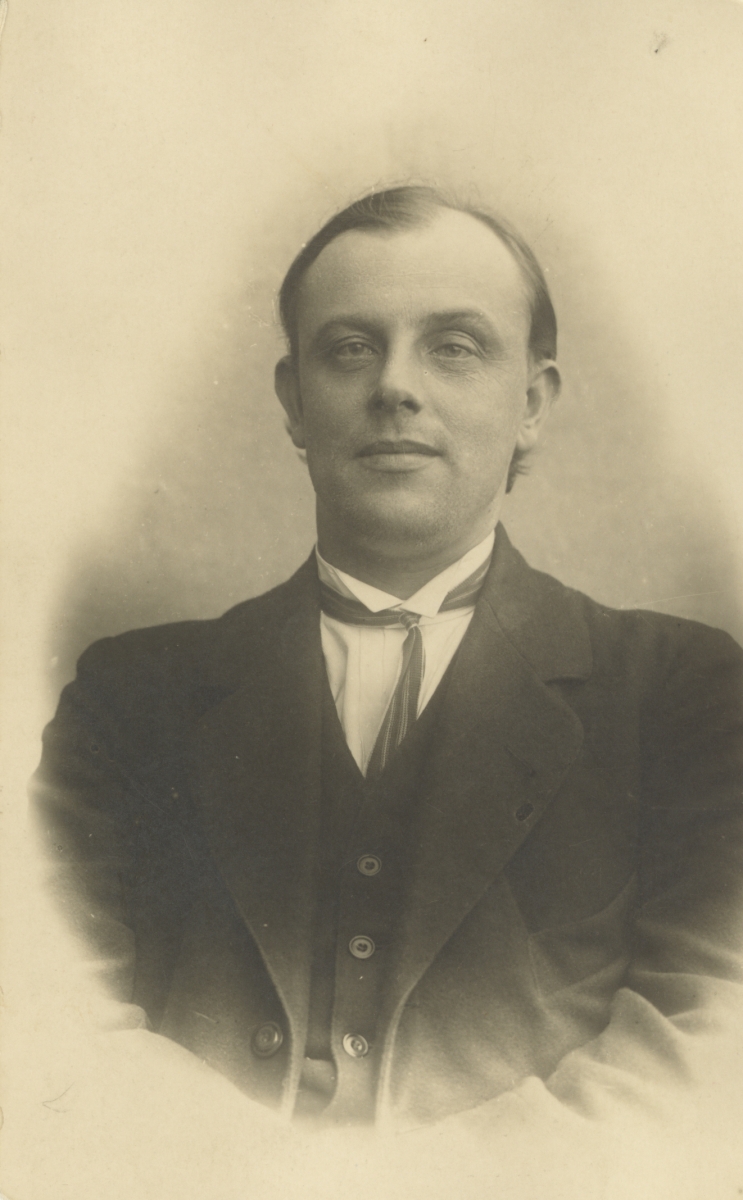
Hendrik Adamson
Poems
Short stories
About Hendrik Adamson
Hendrik Adamson (6. X 1891 – 7. III 1946) was a poet who also wrote short prose. He was born in Southern Estonia in Viljandimaa, Kärstna parish. His school journey began in a local parish school and continued at the Tartu Teachers’ Seminary from 1907-1911. Afterwards, he worked as a teacher and school principal, remaining the longest at his native Kärstna school. In 1927, because of a worsening lung illness, Adamson quit his pedagogical work. He lived frugally at a small farm in Kärstna, living only off his writing. In the 1940s, he returned to teaching for a very short period of time. Adamson died in Kärstna in 1946.
While teaching in Kärstna, Adamson read primarily Russian and Estonian literature. Following the example of the nineteenth century Estonian romantic national poets (especially Ado Reinvald), he also began his first verse attempts. During his time at the Tartu Teachers’ Seminary, he started reading the works of famous Western authors (Goethe, Schiller, Ibsen, Hauptmann, Jack London, and others). As a young teacher, Adamson began from 1913 to publish several short stories and poems in newspapers. Especially his poems interested the writer and critic Friedebert Tuglas, who went on to compile and edit a large part of Adamson’s poetry collections.
Adamson’s first poetry book Mulgimaa (1919) attracted attention despite its small volume. With its authentic approach to land and nature, it came across as exceptional and fresh in contrast to the endeavors of symbolism and modernism of the time. It consisted of lyrical tones as well as folk humor, most of which were written in Adamson’s local Mulgi dialect. Nature, village life, and the moods of Mulgimaa remained keywords in Adam’s future poetry, and he was known above all as the “Mulgimaa laulik” (‘the Bard of Mulgimaa’). His second collection Inimen (‘Human’, 1925), however, contained also many texts in standard Estonian and philosophical abstractions. The third collection Tõus ja mõõn (‘High Tide, Low Tide’, 1931) was again dominated by dialect and tonal images, yet showed more reverence toward form and experimentation of language and verse as well as some artificiality. Adamson’s more traditional style returned in his fourth, elegiac collection Kolletuspäev (‘Day of Withering’, 1934). His most mature and multifaceted poetry collection is considered to be Mälestuste maja (‘House of Memories’, 1936), whose poetics are formed – more than in previous collections – from the elements of older and newer Estonian folksongs. The central part of the collection Linnulaul (‘Bird Song’, 1937) consists of ballads, many of which rely on folklore. The manuscript Seitsmes (‘Seventh’), which consisted of poems from the years 1937-42, remained unpublished. Several select collections of Adamson’s poetry have been published posthumously, and in 2008 his collected poems were published.
Adamson’s short prose, the best of which is written in witty and sharp language, includes Roheline sisalik (‘The Green Lizard’) and Kuldblond neitsi (‘Golden Blonde Virgin’) published in 1925 as well as posthumous collections. He also published autobiographical stories Kuldsel elukoidikul (‘At the Golden Dawn of Life’, 1928), Auli (‘Auli’, 1929 in the journal Looming), and Auli kiusatus (‘Auli’s Temptation’, 1931 in the supplement of the newspaper Sakala). The latter two were published in 1989 in the book Auli (‘Auli’).
It is worth noting that Adamson also wrote original poetry and prose in Esperanto, which was published in several journals; likewise his works in Estonian have been translated into Esperanto. The story Auli and the poetry collection Vesperkanto (‘Õhtulaul’, or ‘Night Song’) were published as books (in 1934 and 1967 respectively). An Esperanto-language memorial stone has been placed on Adamson’s grave in Helme cemetary.
E. S. (Translated by M. M.)
Books in Estonian
Poems
Mulgimaa. Tartu: Odamees, 1919, 47 lk. [2. trükk: Tartu: Noor-Eesti, 1936, 57 lk.]
Inimen. Tartu: Noor-Eesti, 1925, 62 lk.
Hulkuw laip: (poeem-grotesk). Viljandi: Sakala, 1927, 14 lk.
Tõus ja mõõn: luuuletised. [Tartu]: Eesti Kirjanikkude Liit, 1931, 46 lk.
Kolletuspäev. [Tartu]: Eesti Kirjanikkude Liit, 1934, 57 lk.
Mälestuste maja: luuletisi. [Tartu]: Eesti Kirjanikkude Liit, 1936, 70 lk.
Linnulaul: luuletusi. [Tartu]: Eesti Kirjanikkude Liit, 1937, 67 lk.
Kolm pilku. Toimetanud Aino Kosesson ja Endel Köks, eessõna Harald Parrest. Geislingen: [1947], 30 lk.
Kogutud luuletused. Koostanud ja järelsõna Arvo Mägi. Stockholm: Vaba Eesti, 1963, 300 lk.
Hendrik Adamson. Koostanud Ain Kaalep. Tallinn: Eesti Raamat, 1965, 145 lk. [Sari ‘Väike luuleraamat’.]
Vikerkaar ja vari. Koostanud Hando Runnel. Tartu: Ilmamaa, 1998, 95 lk.
Laotuse õlman: ma muigan mu mulgi murden: 1919–1945. Koostanud Hando Runnel. Tartu: Ilmamaa, 2001, 102 lk.
Om maid maailman tuhandit: kogutud luuletused. Koostanud Hando Runnel. Tartu: Ilmamaa, 2008, 731 lk.
Elu sõnad. Järelpõiming. Koostaja ja saatesõna Hando Runnel. Tartu: Ilmamaa, 2020, 149 lk.
Short stories
Roheline sisalik. Tartu: Noor-Eesti, 1925, 66 lk.
Kuldblond neitsi. [Eesti: s.n., 1925], 68 lk.
Kuldsel elukoidikul: jutustus lapsepõlvest. Viljandi: H. Adamson, 1928, 111 lk.
Auli: lugu ühest väikesest poisist. Koostanud Hando Runnel. Tallinn: Eesti Raamat, 1989, 76 lk.
Kuldsel elukoidikul. Koostanud ja järelsõna Hando Runnel. Tartu: Ilmamaa, 2011, 479 lk.
Pastaldega pikne. Koostanud Hando Runnel. Tartu: Ilmamaa, 2013, 302 lk.
Correspondence, diary
Kirjade kuningas. Koostanud Hando Runnel, toimetanud Katre Ligi. Tartu: Ilmamaa, 2023, 255 lk.


